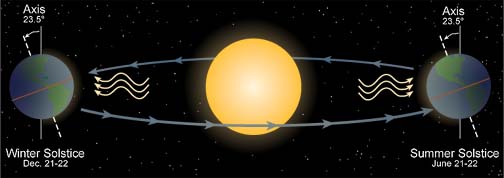The same thing happens in the southern hemisphere. The southern hemisphere also it winter, and it occurs precisely during our summer. In other words, in the southern hemisphere when the South Pole or the axis of the South Pole is pointing away from the sun, the sun's rays have to go through a greater amount of atmosphere. Therefore, more of it is either reflected or absorbed in the atmosphere and less of it reaches the surface of the earth, as well as the fact that the solar energy striking the earth at an angle like that causes it to be spread out over a larger area of the earth's surface. Consequently, the closer one gets to the equator the better off you are in terms of reception of solar energy.

Which of the following statemens is not true?
- a. Near the equator the sunlight falls perpendicular to the Earth's surface.
- b. Towards the poles the same amount of sulight falls over a much large surface.
- c. The tilt of the Earth on its axis caused variation in sunlight directness.
- d. The poles receive direct sunlight only during six months of the year.
Created by the Multimedia Development Lab, Academic Technology Services.
Last modified November 19, 1997.